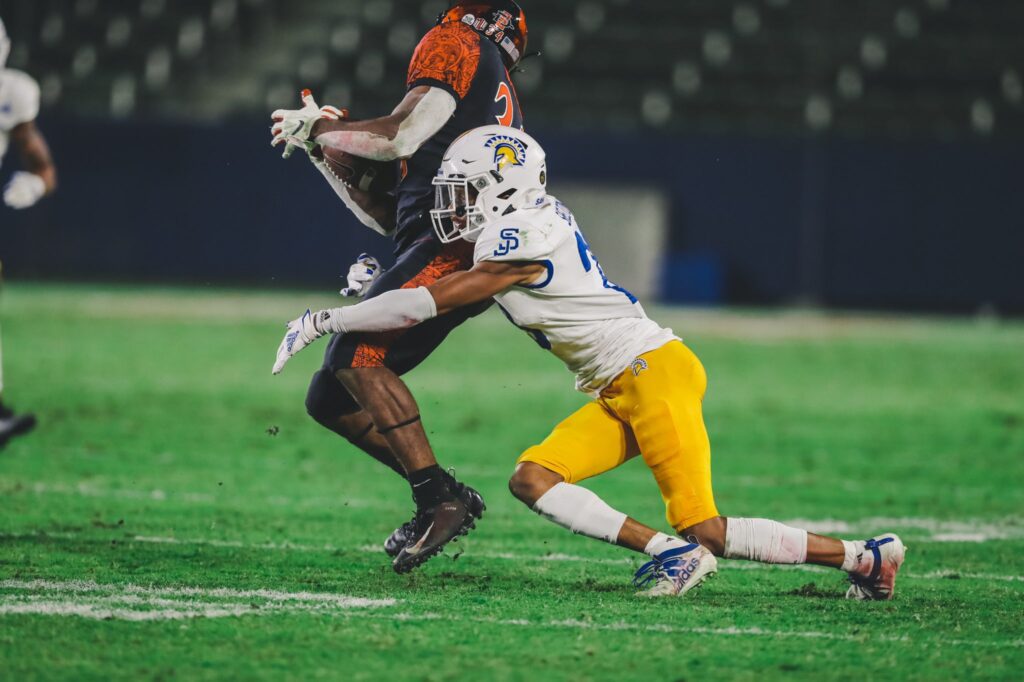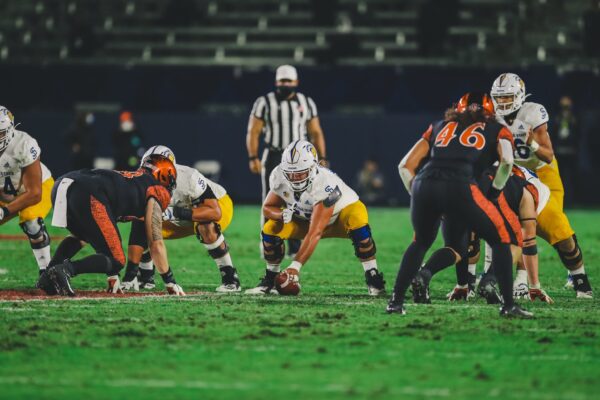Observations following an Aztecs loss to San Jose State

Credit SJSU

A few observations after a big Aztecs loss to San Jose State University.
1. The narrative coming into the game was the Aztecs were facing a graduate transfer quarterback, Nick Starkel, who had blossomed in the same, unexpected manner Yanni Wetzel did for the Aztec basketball team. NFL scouts were in attendance to get a closer look at his meteoric rise onto the NFL Draft radar. The Aztec coaching staff could be forgiven for missing an opportunity to bring Starkel to the Mesa. After all, most of the country missed him on him too. However, this story did not play out on Friday.
Instead, it was a sophomore quarterback – not name Carson Baker – who came in and was the best player on the field. Aztec fans have grown used to seeing seemingly every other team in the conference recruit and develop better signal-callers. Recent NFL Draft picks Josh Allen, Jordan Love and Cole McDonald are all from the state of California. The Aztecs did not recruit any of them, each chose a rival Mountain school, and each led less talented teams to victories over the Red and Black. While it is too early to add San Jose State’s Nick Nash to that list. He does check three of the four boxes. He is a native of Irvine, CA, he was not recruited by San Diego State, and he led a Spartan team that was outmatched at almost every position to victory. All that is left for him to join this prestigious group is to develop into an NFL quarterback. For all of its successes and accomplishments, yesterday’s game was a stark reminder of SDSU’s biggest weakness. They have not developed elite players at the QB position … yet.
2. Speaking of the quarterback position, it is easy to blame yesterday’s loss on Carson Baker. Baker made huge mistakes, which contributed to the defeat. Meanwhile, on the other sideline, his counterpart made huge plays to lead his team to victory. A closer look, however, suggests a different culprit: coaching. The Aztec and Spartan coaching staff, locked in a close game in the fourth quarter, each had inexperienced signal-callers at the helm, but their approach to these similar circumstances could not have been different. Two drives paint the picture.
The first, with the Aztecs up 17-14 and in possession of the ball. They had an opportunity to put the game away and pressure Carson Baker to make the right play. On first down, they called a read option, which Baker misread and kept instead of giving the ball to Greg Bell. On second down, they called the ill-fated screen pass that resulted in the -21 yard lateral and turnover. A screen invites pressure on the QB to be effective. Should the coaching staff have put the fulcrum of their success on a player with only three previous starts instead of playing it safe and depending on its defense?
Hindsight is 20/20, but San Jose State handled this situation in just that manner. Two possessions later, with six minutes to play, the Spartans had the ball up 21-17. The SJSU coaching staff called four consecutive runs and punted. In fact, Nick Nash only attempted two passes the entire fourth quarter. Rocky Long often said coaches never win a game, but they can lose it. Friday was an example of the latter.
3. Friday provided us a possible glimpse of the differences between a Hecklinski ran offense under Brady Hoke, and a Jeff Horton ran offense under Rocky Long. With about six minutes left to play and San Jose State clinging to a four-point lead. The Aztecs lined up 15 yards from the end zone, facing a third and fourteen. Under Long, Horton would have likely called a run and set up a field goal. On Friday, Hecklinski called a pass that was intercepted in the end zone. The formula under coach Long was a recipe for success. It is too soon to tell if Hoke’s philosophy will deviate from his predecessor, but he did and lost in this game.
4. The NCAA rule book gives examples to clarify their rules. Below is the clarification for kick-catch interference most related to the decisive non-call on Jordan Byrd’s fumble of a punt late in the game. SJSU defender, Tre Walker, was within a yard of Byrd when the ball arrived. He did not make contact before the ball bounced off Byrd’s helmet. The rule clearly shows a penalty should have been called because Walker was “in front” of Byrd and not beside him. Byrd also had to adjust the way he caught the ball because Walker was bearing down on him.
“Punt receiver B44 is standing at his 30-yard line in a position to catch the kick. Defender A11 races down the field to cover the punt and reaches a point about a foot directly in front of B44 as the ball descends. B44 makes the catch without adjusting his position or manner of catching the ball because of the presence of A11, who does not pull back to give B44 more room. RULING: Foul for kick-catch interference. A11 entered the one-yard area directly in front of receiver B44. 15-yard penalty.”
4. San Diego State had defeated San Jose State seven consecutive games before Saturday. The Aztecs’ potent running attack was the main reason why. In those wins, SDSU averaged 302 yards a game compared to 62.4 for SJSU. Friday, the Spartans outgained the Aztecs on the ground 116-101. The Boys from the Bay Area had shown signs of being better than their national rankings indicated. They came into the game 65th in the nation in rushing defense, but that included a game against Air Force, which skews the numbers because of the Falcons option attack.
5. Two impressive defensive streaks came to an end on Friday night. SDSU’s defense held their opponents to 17 points or less in the nine previous games, and no opponent had scored two scores in one quarter for 41 straight quarters. If not for a couple of turnovers giving SJSU short fields in the four-quarter, both streaks might still be intact. Ironically, losses have a way of illuminating strengths. The Aztec defense was not its customary, attacking self; instead, they spent much of the second half off-balance, reacting to what the Spartans were doing. Seeing it was odd because few teams have been able to accomplish that against this terrific group.
6. BYU, thankfully, is no longer in the same conference as the Aztecs, but they could be the main cause nonetheless for the Aztecs failing to make the Mountain West title game. This season, the two teams with the highest winning percentage will meet in the championship regardless of division. Unlike most in the conference, SDSU has seven, not eight conference games. Simple math shows winning seven of eight games yields an 87.5% winning percentage; winning six out of seven equals 85.7%. There is a lot of football left to be played, but, perhaps, Rocky Long was right yet again: Never schedule BYU.
My earliest sport’s memory involve tailgating at the Murph, running down the circular exit ramps, and seeing the Padres, Chargers and Aztecs play. As a second generation Aztec, I am passionate about all things SDSU. Other interests include raising my four children, being a great husband and teaching high school.